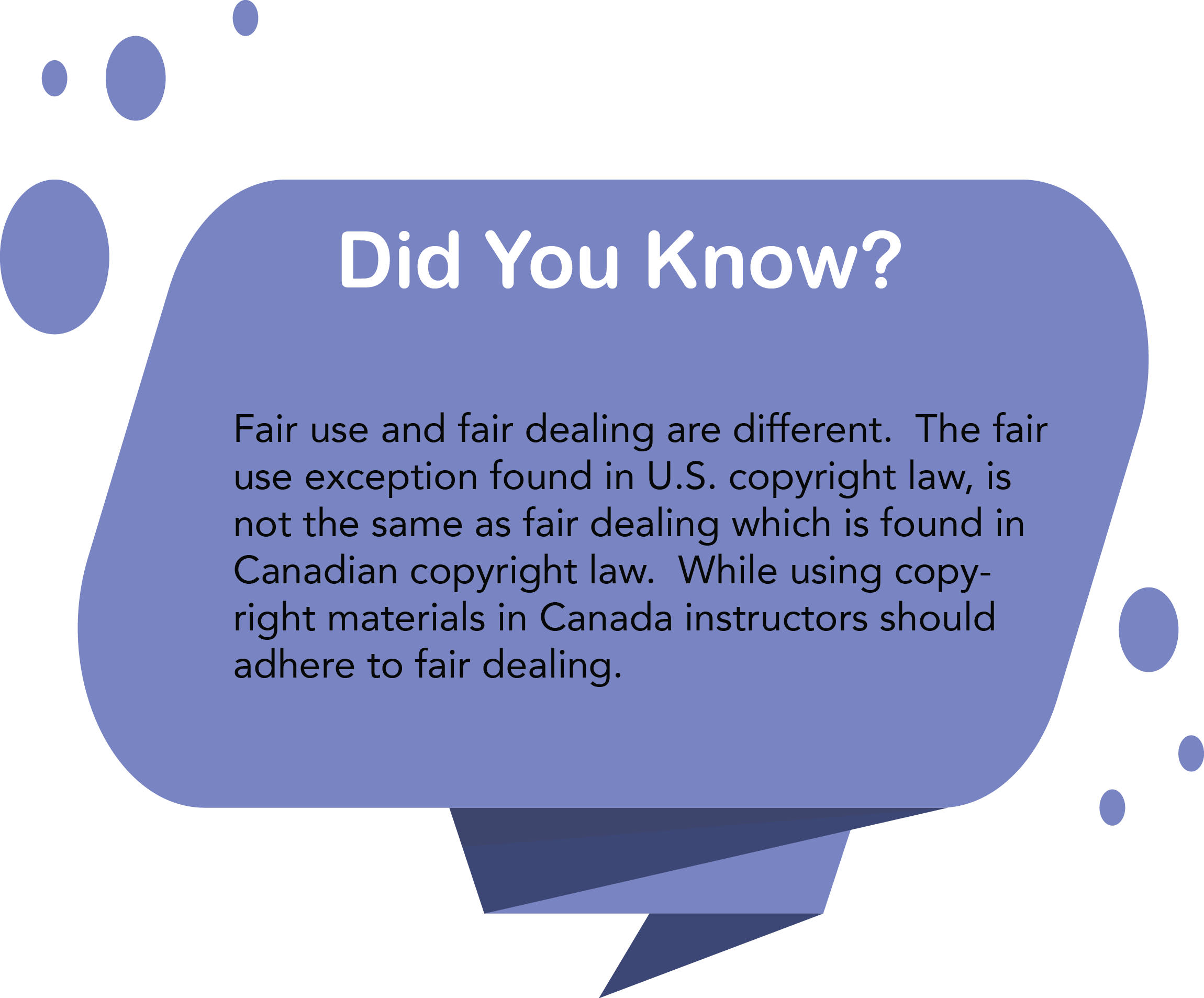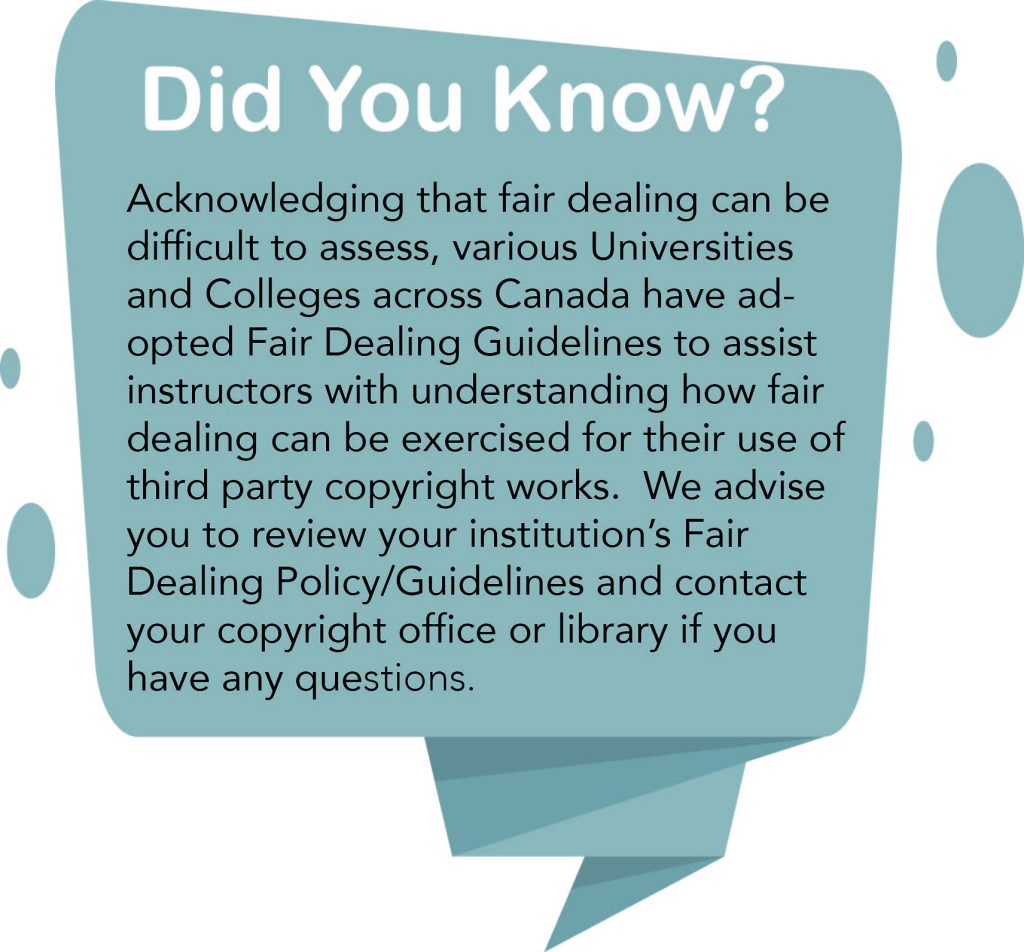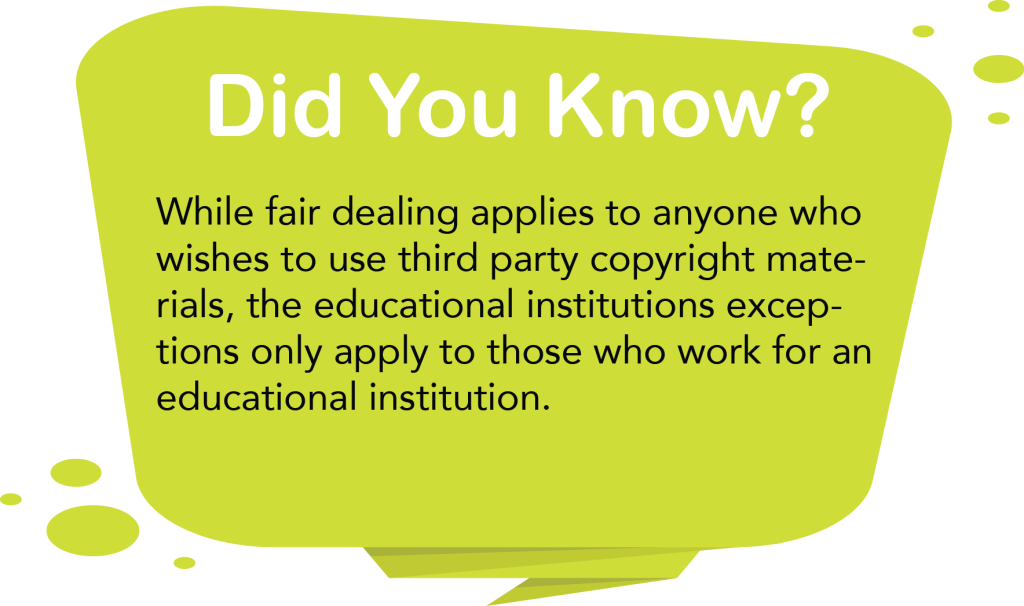The story of copyright is either explained through the lens of the user or the owner. At an academic institution, such as a University or College, an instructor can as quickly become users as they would be owners of copyright. In research for example, faculty can use third party copyright works such as scientific databases, or questionnaires in conducting their research project, and in turn write an article for an academic journal based on that same project. In the former the instructor is the user of copyright and in the latter the author and owner of the copyright. When the instructor uses copyright works that they have created, they generally own those works, unless specific exceptions apply. That means that the instructor owner has certain exclusive rights to their works, as provided to them in the Copyright Act, R.S., c. C-30, s. 1. For example, for literary works, the Copyright Act, provides and owner the sole right to produce or reproduce the work or any substantial part of the work in any form, to perform the work in public or, if the work is unpublished, to publish the work or any substantial part of it. It also grants the owner the right to authorize anyone to any of the foregoing.
As previously mentioned an instructor is not always just an author/owner of copyright work, and in order to provide instruction to their students, instructors often seek the assistance from third party copyright works. That is to say, generally speaking if an instructor wishes to use third party copyright works they would need to seek their permission to do so, unless the instructor falls under one of the statutory exceptions, which would grant  an instructor the ability to use a third party’s copyright works without permission and still be in compliance with copyright law. These exceptions are listed below.
an instructor the ability to use a third party’s copyright works without permission and still be in compliance with copyright law. These exceptions are listed below.
Copyright Act Exceptions
Fair Dealing
Fair dealing is a statutory exception that would permit an instructor to use third party content without first seeking permission from or making payment to the copyright holder, so long as a two prong test is met. First the instructor must be using the copyright works for either, research, private study, criticism or review, parody, satire, new reporting or education. For the most part, it can generally be easy for an instructor to fall under one of the purposes. However the second part of the test, can and is, a little more complicated. Once an instructor knows that they are using third party copyright works for one of the fair dealing purposes, they then have to meet the second part of the test – that dealing is fair. Although what is “fair” is not defined in the Copyright Act and is a question of fact, there has been Supreme Court of Canada cases that have provided insight to the question of fairness. Most notably, the the Supreme Court of Canada, in CCH Canadian Ltd v. Law Society of Upper Canada, [2004] 1 SCR 339, 2004 SCC 13, provided a six factor analysis that can be used in determining the fairness of the dealing. The factors are:
- The purpose of the dealing.
- The character of the dealing.
- The amount of the dealing.
- Alternatives to the dealing.
- The nature of the work.
- The effect of the dealing on the work.
 Not one factor is more important than another, and all should be taken together in an assessment of fairness. If you are having difficulty figuring out whether your dealing is fair, you could try using Queen’s University Fair Dealing Evaluator or try contacting your academic institution’s copyright specialist for assistance.
Not one factor is more important than another, and all should be taken together in an assessment of fairness. If you are having difficulty figuring out whether your dealing is fair, you could try using Queen’s University Fair Dealing Evaluator or try contacting your academic institution’s copyright specialist for assistance.
Educational Exceptions
Educational institutions exceptions are yet more statutory exceptions, but only available for the purpose of providing education and instruction on the premises of an educational institution. That means that a University or College and any instructor acting under its authority can do any of the following:
1.Reproduction for Instruction or Examinations – reproduce a work or o any other necessary act in order to display it for the purposes of training or education on its premises. While display is not defined in those section or under the Copyright Act, it is likely to include display of work through computers and tablets. There are restrictions however and they are with respect to non-manual reproductions (ie. copying a work onto a board, flip chart or similar surface). Therefore, in this case, these types of reproductions can only be done if the copyright material in use can’t be commercially available, and located within a reasonable time and for reasonable price.
2. Performances – carry out the following performances, on the educational institution’s premises for educational or training purposes and not for profit, before an audience consisting primarily of students, faculty or any person who is directly responsible for setting a curriculum for the educational institution:
- the live performance in public, primarily by the students of the educational institution, of a work;
- the performance in public of a sound recording or of a work or performer’s performance that is embodied in a sound recording;
- the performance in public of a work at the time of its communication to the public by telecommunication; and/or
- the performance in public of a cinematographic work.
The performances would need to be based off a non-infringing copyright work;
3. Reproduction of Broadcasts – make a single copy of a work at the time that it is communicated to the public by telecommunication; and keep the copy for up to thirty (30) days to decide whether to perform the copy for educational or training purposes;
4. Reproduction of News Commentary – communicate a lesson (including tests or exams), to the students enrolled in that specific course, by telecommunication for education or training purposes, and record such lessons. The student can also make a copy of such telecommunicated lesson to be viewed or listened to at a later time, provided that:
- the student and the institution must destroy the recording or copy within 30 days after receipt by students of their final course evaluations;
- the institution must take reasonable measures to limit the audience to students only, and to prevent the students from fixing, reproducing or communicating such lessons except as permitted under this exception.
The recordings cannot be sold or distributed widely (beyond the audience of students enrolled in the class);
5. Reproduction for Lessons by Telecommunication – communicate a lesson (including tests or exams), to the students enrolled in that specific course, by telecommunication for education or training purposes, and record such lessons. The student can also make a copy of such telecommunicated lesson to be viewed or listened to at a later time, provided that:
- the student and the institution must destroy the recording or copy within 30 days after receipt by students of their final course evaluations;
- the institution must take reasonable measures to limit the audience to students only, and to prevent the students from fixing, reproducing or communicating such lessons except as permitted under this exception.
The recordings cannot be sold or distributed widely (beyond the audience of students enrolled in the class);
6. Works Available Through the Internet – reproduce, communicate by telecommunication and perform for an audience consisting primarily of students or other persons acting under the educational institution’s authority, for educational or training purposes, works or other subject matter that is available through the Internet, unless:
- the works are protected by a Digital Lock that restricts access to the work or other subject-matter or to the website;
- a clearly visible notice (and not merely the copyright symbol alone) prohibiting such act is posted on the website or on the work or other subject matter itself; or
- the educational institution or person acting under its authority knows or should have known that the works were made available on the Internet without consent of the copyright owner;
and the following must be mentioned in respect of the work:
- the source; and
- name of author, performer, maker or broadcaster (if provided in the source);
7. News and Commentary – make, at the time of its communication to the public by telecommunication, a single copy of a news program or a news commentary program, excluding documentaries, for the purposes of performing the copy for the  students of the educational institution for educational or training purposes; and perform the copy in public before an audience consisting primarily of students of the educational institution on its premises for educational or training purposes.
students of the educational institution for educational or training purposes; and perform the copy in public before an audience consisting primarily of students of the educational institution on its premises for educational or training purposes.
Educational institutions relying on this exception no longer have to pay royalties, destroy copies of news or commentary programs after one year, or keep records of the copies made of news or commentary program;
8. Reproduction for Persons with Perceptual Disabilities – copy an entire work (other than a cinematographic work) into an alternative format including translation, adaptation and performance in public (except the making of a large-print book) for the purpose of serving students with perceptual disabilities as long as such an adaptation is not already commercially available in that format.
References
The above content on educational exceptions was adapted from “Educational Exceptions” created by the Scholarly Communications and Copyright Office, University of British Columbia under a Creative Commons Attribution-ShareAlike 4.0 International License.
